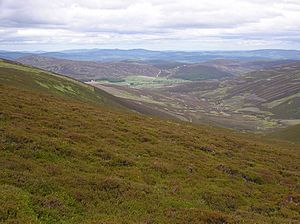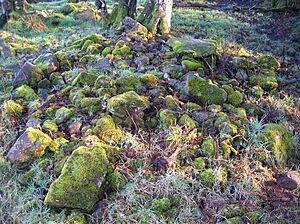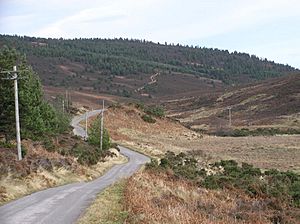Forest of Birse facts for kids
Quick facts for kids Forest of Birse |
|
|---|---|
| OS grid reference | NO5390 |
| Council area | |
| Lieutenancy area | |
| Country | Scotland |
| Sovereign state | United Kingdom |
| Post town | Banchory |
| Postcode district | AB31 |
| Dialling code | 01330 |
| Police | Grampian |
| Fire | Grampian |
| Ambulance | Scottish |
| EU Parliament | Scotland |
| UK Parliament |
|
| Scottish Parliament |
|
The Forest of Birse is a wild, hilly area in Aberdeenshire, Scotland. It's located in the upper part of the Water of Feugh river system, which flows into the River Dee. This area is part of the larger Birse parish.
The Forest of Birse has a long and interesting history, especially about who owns the land and who can use it. For hundreds of years, there have been arguments over its status as a "commonty," which means land that many people have rights to use. Today, it's a popular spot for people from Aberdeen to visit, especially for picnics, because it's the closest place to experience the beautiful Highland scenery.
Contents
Exploring the Forest of Birse
The Forest of Birse covers about 35 square kilometers. Its eastern edge is marked by two small streams, the Finlets and Laird's burns, which flow into the Feugh river. The rest of the boundary generally follows the tops of hills, like Baudnacauner, Cock Hill, and Gannoch. The highest point in the forest is Gannoch, which stands at 731 meters (about 2,400 feet) tall.
Rocks, Soil, and Habitats
The ground in the Forest of Birse is mostly made of granite rock. This granite forms most of the soil here. However, on many of the higher hills, there's a thick layer of peat. Peat is a type of soil made from decayed plants, and it creates large areas of "blanket bog," which are like spongy, wet grasslands.
Historically, a 'Forest' didn't always mean a place full of trees. It was an area set aside for hunting, and it might not have had many woods at all. In the Forest of Birse, the main type of land is heather moorland, which is open land covered in heather plants.
Since the Second World War, about 5 square kilometers of native pine woodland have grown back on the northern slopes of the forest. You can find these trees on hills like Finlets, Lamahip, and Bogturk. Along the streams, there are also small areas of woodland with different native trees like birch, hazel, aspen, and holly.
Homes in the Forest
Within the Forest of Birse, there are only two small areas where people live and farm: Auchabrack and Ballochan. These places have the only buildings in the forest, including the historic Birse Castle and three other houses.
Amazing Wildlife
The Forest of Birse is home to many interesting animals and birds. You might spot mountain hares, red deer, and roe deer. For birds, there are red grouse, black grouse, golden plover, hen harriers, merlins, and peregrine falcons. You might also see crossbills. Sometimes, golden eagles and capercaillie visit the area.
Because of its rich wildlife, part of the Forest of Birse was named an Important Bird Area by BirdLife International. There was also an attempt in the early 1990s to make part of it a Site of Special Scientific Interest, which would give it special protection.
A Look Back in Time
The Forest of Birse has a long history of human activity. The very first people here were hunter-gatherers about 8,000 years ago, during the Mesolithic period.
Early Settlements
The first clear signs of people living here come from the Bronze Age, about 3,000 years ago. You can still see evidence of their field systems (old farm fields), clearance cairns (piles of stones cleared from fields), and hut circles (the stone foundations of ancient homes). Back then, people probably grew cereal crops in areas that are now covered with heather.
Around the start of the British Iron Age, the climate got colder and wetter. Because of this, these early farms were likely abandoned, and nature slowly reclaimed the land. The Forest of Birse then remained mostly uninhabited until the 1600s.
Royal Hunting Ground
By the 10th century AD, the Forest of Birse belonged to the King of Scots. It was used as a special Royal Hunting Forest where kings like Kenneth II and Kenneth III would hunt.
In 1170, King William the Lion gave Birse to the Bishop of Aberdeen. This was the first time the uninhabited Forest of Birse was mentioned as a separate area from the rest of Birse, where most people lived. For the next 400 years, the Bishops allowed the local people to use the forest. They had "common rights" to collect timber (wood), cut peat (for fuel), and let their animals graze there in the summer.
Changing Hands and Disputes
Between 1549 and 1620, around the time of the Protestant Reformation, the Bishop of Aberdeen sold off their lands in Birse. The new landowners, and their tenants, were also given the common rights to use the forest.
However, in 1585, the forest itself was sold to William Gordon of Cluny. In 1610, the Gordons tried to take over the best grazing areas, building a castle and bringing in their own farmers. But after falling into debt, the Gordons sold the forest in 1636. In 1640, the other landowners in Birse fought back. They burned down Birse Castle and forced the new farmers out to get their common rights back. In 1666, the forest was sold to the Earl of Aboyne.
Legal Battles Over Land Use
In 1724, the Earl of Aboyne again tried to claim the land around Birse Castle for himself, bringing in new farmers. Around the same time, another family, the Farquharsons of Finzean, also took over an area called Auchabrack. These actions led to legal arguments with other landowners who had rights in the forest.
These disputes were finally settled by the Court of Session in 1755. The court decided that the two enclosed areas (around Birse Castle and at Auchabrack) could remain private property. But, it also confirmed that everyone else in Birse still had their common rights over the rest of the forest.
Hunting Rights and New Owners
During the 1800s, grouse shooting became very popular and valuable, especially during the Victorian era. This led to more legal arguments, this time about who had the right to hunt in the forest. These arguments weren't fully settled until 1897.
The final decision was that while the Earl of Aboyne owned the land, the hunting rights were shared between him and the nearby Ballogie estate. This division of hunting rights still exists today.
In the same year (1897), the Earl of Aboyne sold the Forest of Birse to Joseph Robert Heaven, who rebuilt Birse Castle. After Heaven passed away in 1911, the forest was bought by Weetman Pearson, 1st Viscount Cowdray and became part of his large Dunecht estate. Today, the forest is owned by Charles Pearson, the younger son of the 3rd Viscount Cowdray. The farmland at Auchabrack was sold to the Nicols of Ballogie in 1938.
Modern Management and Community Rights
For most of the 20th century, the Forest of Birse was mainly managed for grouse shooting by the two estates. The older common uses, like summer grazing, cutting peat, and collecting timber, were mostly forgotten.
However, in the 1970s, new trees started growing in part of the forest. When Dunecht estate cut down some older trees, it reminded people about the ancient common rights that all the inhabitants of Birse parish held, including the right to use timber.
After several years of talks, a special agreement was made in 1999. The ancient common rights over the forest were given to a group called the Birse Community Trust. This trust now uses these rights to manage about 5 square kilometers of the regenerating woodland in the north-east part of the forest. The Ballogie and Dunecht estates still manage the rest of the forest, mainly for grouse shooting. All three groups meet regularly to discuss how to best look after the forest together.
Images for kids








